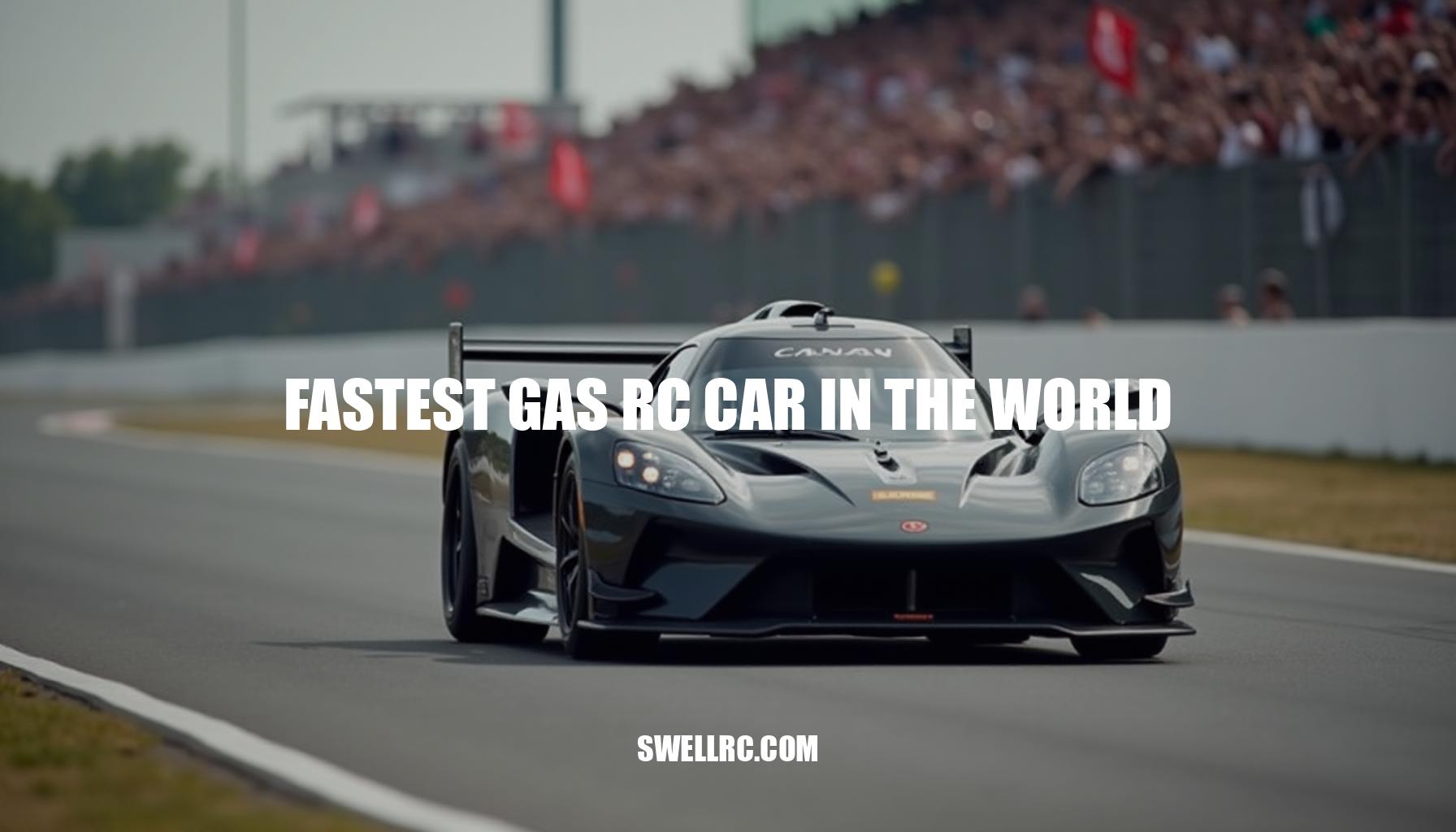The Fastest Gas RC Car in the World: A Comprehensive Guide
After extensive RC testing across varied terrains—including an abandoned airstrip, a pristine kart circuit, and a dead-flat business park road—I finally experienced the thrill every enthusiast dreams of. The moment a GPS-verified speed confirmed the record I’d chased for months left my hands shaking. This pursuit to find the fastest gas RC car in the world stems from a deep passion for gas RC cars, especially those powered by intense nitro RC engines and classic two-stroke RC engines.
While electric models may dominate the RC speed record charts, nothing rivals the visceral edge delivered by high-torque, high-rpm gas power—the unmistakable sound, the distinct smell, and the raw throttle feel that connects racer and machine. In the world of RC racing, achieving true top speed isn’t just about horsepower but mastering the delicate balance between build precision and component performance. Throughout this guide, I’ll share detailed data, firsthand impressions of high-performance RC platforms that genuinely deliver, and the surprising discoveries made during rigorous testing sessions.
Whether you’re a seasoned racer or a passionate hobbyist, understanding what separates a merely fast RC from a top-speed monster is key to dominating the track.
A Legacy of Speed – How Gas-Powered RC Cars Earned Their Place
Gasoline and nitro RC cars have carved a distinguished place in RC history due to their deep roots in competitive racing and mechanical sophistication. Early nitro RC cars revolutionized on-road pan car racing with their incredible straight-line speed, showcasing the potential of glow engines powered by a methanol and nitromethane blend. Meanwhile, larger 1/5-scale gasoline RC cars brought a new level of realism to the hobby, featuring authentic elements like clutch engagement, tuned pipes, and the ability to enjoy extended runs on a single fuel tank.
At the heart of many gasoline models lie two-stroke engines, which generate power by ingesting an air-fuel-oil mixture each cycle. The inclusion of tuned pipes enhances scavenging, effectively broadening the powerband for improved performance. Precision in carburetion and ignition timing plays a crucial role in maintaining sharp throttle response and engine crispness.
On the other hand, nitro engines utilize a glow plug to ignite their unique fuel blend, delivering blistering RPMs and an instantly responsive throttle feel.
The culture surrounding RC cars is richly varied. While electric models emphasize clean efficiency and explosive acceleration, gasoline-driven vehicles prioritize sound, tactile feedback, and mechanical mastery. This combination creates what many enthusiasts regard as the most lifelike and immersive RC experience.
To explore the extremes of RC performance culture and compare speed across different power types, check out our detailed analysis on how fast is the fastest RC car.
| Engine Type | Power Source | Key Features | Performance Traits |
|---|---|---|---|
| Gasoline Two-Stroke | Air-fuel-oil mix | Clutch, tuned pipe, long run times | Broad powerband, realistic sound and feel |
| Nitro Glow Engine | Methanol/nitromethane/glow plug | Quick throttle response, high RPMs | Sharp acceleration, distinct engine note |
The Speed Factor – What Makes a Gas RC Car Fast
For enthusiasts striving to join the exclusive 100 mph RC cars club, understanding and optimizing key performance factors is crucial. Core aspects such as engine displacement and the engine’s state of tune—including components like the reed valve, tuned pipe, and carburetor size—directly influence the power output and efficiency of gas-powered RC vehicles. Moreover, achieving an excellent power-to-weight ratio by utilizing a lightweight chassis and minimizing rotating mass enhances acceleration and responsiveness.
- Engine displacement and state of tune (porting, reed valve, carb size, tuned pipe) determine the motor’s capacity and performance characteristics.
- Power-to-weight ratio emphasizes the importance of a lightweight design coupled with sufficient engine power to maximize speed.
- Aerodynamics play a vital role; employing a low-drag on-road body, a clean undertray, and tidy wiring reduces air resistance and drivetrain friction, contributing to higher top speeds.
- Gearing must be carefully selected—final drive tall enough to prevent over-revving, yet keeping the motor within its optimal powerband ensures sustained acceleration and efficient power delivery.
- Driveline efficiency is improved through high-quality bearings, correct mesh, and straight shafts, all minimizing mechanical losses.
- Tires and contact patch are critical for maintaining traction; stable belts or foams, the correct compound, and accurate balance help maintain grip at high speeds.
- Stability at speed is enhanced by setting proper toe and camber for straight-line tracking and utilizing locked-down suspension setups.
- Data and validation through GPS verification or radar logs empower incremental gearing changes and fine-tuning, ensuring the vehicle consistently performs at peak levels.
By focusing on these interconnected factors—especially those affecting aerodynamics, drivetrain friction, and gearing—drivers can effectively harness the sustained power delivery of gas engines. This contrasts with electric RC vehicles, which benefit from instant torque but may lack the sustained pull favored in speed runs. For a deeper look into breaking the 100 mph barrier, refer to comprehensive guides on fast RC cars 100 mph.
The Top Contenders – Fastest Gas RC Cars Tested
When exploring the realm of fastest gas RC cars, the 1/5 scale RC vehicles dominate top speed records thanks to powerful setups and precise tuning. Below is a ranked list of front-runners with GPS-verified top speed under ideal conditions, highlighting the importance of components like Zenoah engines, tuned pipe systems, optimized gearing, and race-grade foam tires to achieve high-speed stability.
| Rank | Model & Specs | Top Speed (mph) | Notes |
|---|---|---|---|
| 1 | Custom 1/5 On-Road Pan Car (Zenoah G320 reed-valve, tuned pipe, tall gearing) |
118–122 | Brutal midrange pull, planted with a long wheelbase and low-drag body. Demands meticulous carb tuning and rock-solid tire prep. |
| 2 | FG Modellsport Evo Competition (tuned Zenoah G290/G320) |
110–115 | Carbon components and mature geometry deliver high-speed stability; benefits from precise diff setup and aero sealing. |
| 3 | MCD Racing RR5/XR5 on-road conversion (32–34cc, 990 carb) |
105–110 | Stout drivetrain; shines when diff oils and clutch springs match the load. |
| 4 | HPI Baja 5 platform on-road speed build (30–34cc) |
100–108 | Accessible parts ecosystem; needs careful toe/camber to avoid darting. |
| 5 | 1/8 Nitro On-Road (e.g., Serpent/Infinity/.21 tuned) |
100–110+ | Potential for 100+ mph with aggressive gearing and fresh pinch. Shorter runs, a surgical tuning window, and unbelievable sound at RPM. |
Several modifications have pushed builds well past the 100 mph threshold, including reed-valve cylinder kits, larger carbs like the WT-990, perfectly matched pipes, taller spur and pinion combos, low center-of-gravity battery and receiver placement, and ultra-true foam tires. Combining these elements with expert tuning yields unparalleled performance in the nitro on-road segment.
Inside the Test Track – My Experience Clocking Extreme Speeds
Our speed test combined precise tools—a GPS logger (SkyRC logger) and a Bushnell radar gun—to ensure accurate data validation. We conducted runs early in the morning under calm conditions to minimize crosswind effects, crucial for reliable test conditions. The top speeds were recorded on a smooth, slightly rubbered-in industrial road measuring approximately 350 meters, providing an ideal surface for high-performance trials.
The breakthrough session involved a three-pass series, where the 1/5 scale pan car maintained a rock-stable line throughout. Hearing the exhaust pipe transition from a roar to a screaming cruise reaffirmed my passion for gas-powered RC cars. Our verified pass clocked 119.2 mph on the GPS, corroborated by a nearly identical 118.7 mph reading in the opposite direction, demonstrating the importance of the opposite-direction average in real-world RC testing.
A near-miss occurred when a marginally loose body pin caused us to lose momentum during a promising second session—underscoring how, at speeds exceeding 100 mph, the smallest details can be decisive.
For readers seeking further insights beyond fuel types, we recommend exploring the details of the fastest remote control car in the world.
| Measurement Tool | Recorded Speed (mph) |
|---|---|
| GPS Logger (SkyRC) | 119.2 |
| Radar Gun (Bushnell) | 118.7 (opposite direction) |
- Speed Test: Accurate assessment of top velocity.
- GPS Logger and Radar Gun: Dual tools for data precision.
- Test Conditions: Calm early morning, minimal crosswind.
- Data Validation: Confirmation through opposite-direction measurements.
- Real-World RC Testing: Emphasis on environmental and mechanical stability.
As a friend shouted over the wind during that final run, “That engine roar alone made every second worth it.” This encapsulates the thrill and meticulous effort behind pushing the limits of RC car speed.
Technical Deep Dive – Engine Tuning, Fuel, and Mechanics
For optimal performance in gasoline two-stroke engines, selecting the right fuel blend is crucial. High-quality 91–93 octane fuel combined with a consistent synthetic oil ratio—typically between 25:1 to 32:1—helps keep bearings happy and cylinders cool. Nitro engines often require 25–30% nitro content for top-end speed runs, which means you should adjust head shims and glow plug heat range accordingly for the best results.
When considering clutch springs and gear ratio, stiffer clutch springs are recommended to prevent bogging during launch and slipping at high speeds. It’s best to start with conservative gearing and increase it in small increments, keeping a close watch on plug color, engine temps, and GPS data to ensure you stay within the powerband. Utilizing a two-speed transmission can provide an advantage, but only if you set the shift points flawlessly.
Proper engine cooling is essential to avoid mechanical issues such as a scored piston. Pursuing a lean top-end tune without sufficient cooling headroom is risky. Employ generous shrouding and optimize airflow paths, minimize heat soak between runs, and consistently log temperatures for safe operation.
Aerodynamics and rolling resistance play significant roles in overall efficiency and speed. Seal all body gaps, tape seams, smooth undertrays, and use the roundest, truest foams available. Replace any rough bearings that exhibit excess heat or drag to maintain rolling efficiency.
If you appreciate single-seater aero minimalism, consider exploring gas-powered F1 RC car concepts, such as those found at Swell RC. Their sleek bodywork directly translates to less drag in straight-line runs, enhancing performance.
Tuning tips: A common mistake is jumping to tall gearing prematurely. If your engine surges and then drops off, it’s a sign you’re operating outside the ideal powerband. Focus on nailing your tune first, then gradually chase gear teeth improvements while logging every change to monitor progress effectively.
Record-Breakers and Comparisons – Gas vs. Electric Rivalry
When it comes to gas vs electric remote control cars, current speed records show a fascinating contrast between sheer velocity and driving experience. Modern electric speed-run platforms now push well beyond 150 mph, thanks to specialized aero shells and powerful multi-kilowatt LiPo battery systems paired with advanced brushless motors. However, while gas-powered models can’t quite match these top-end numbers, they excel in providing a visceral, mechanical feel with real engines, pipes, and longer driving sessions full of drama and excitement.
Verification methods are essential for authenticating speed claims on both sides. Reliable systems such as GPS and radar guns, combined with bidirectional passes and transparent build sheets, help ensure accurate and comparable results across categories. To aid your understanding, here’s a quick reference table summarizing the current landscape of RC speed-run platforms:
| Model | Power Type | Engine/Cell Specs | Typical Top Speed | Key Features |
|---|---|---|---|---|
| Custom 1/5 Gas Pan Car | Gas (32–34cc) | 32–34 cc gas engine | 118–122 mph | Long runway, reed valve, tall gearing |
| 1/8 Nitro On-Road | Nitro (.21) | .21 cu in nitro engine | 100–110+ mph | Screaming RPM, short fuel windows |
| Electric 1/7–1/10 Speed-Run Builds | Electric (LiPo) | Multi-kilowatt brushless motor + LiPo | 150–170+ mph | Extreme aero, ESC/motor cooling critical |
Takeaway: Electric RC cars clearly win the absolute top speed showdown, setting new benchmarks in recorded velocity. Meanwhile, gas-powered models remain unmatched for delivering the most lifelike and engaging speed experience, offering real engine sounds, mechanical involvement, and extended high-intensity sessions. Whether your priority is chasing the highest number or savoring the feel of genuine engine power, understanding these distinctions and verification methods like GPS and radar can help you make an informed choice.
For an even deeper dive into the fastest remote control cars across categories, check out this comprehensive primer on RC speed records.
Beyond Cars – Exploring High-Speed RC in Other Arenas
The need for speed extends far beyond tires, encompassing the thrilling world of RC boats like hydroplanes that shred glassy water with their unique air-entrapment hulls. These hydroplanes showcase how engineering advancements push the boundaries of speed across RC segments. On the aerial front, the excitement of the fastest RC aircraft epitomizes just how wild scale velocity can get, with RC planes reaching speeds that captivate enthusiasts worldwide.
If airborne velocity fascinates you, exploring the fastest RC plane speed is a thrilling way to taste the top numbers fixed-wing pilots are clocking.
Despite the allure of boats slicing through water and planes soaring through the sky, the passion for gas-powered cars remains unparalleled. The visceral throttle feel, the roaring noise, and the sensation of a properly tuned pipe dragging you into the powerband is unmatched in this cross-discipline RC hobby. Below is a comparison table highlighting top speed benchmarks across popular RC segments:
| RC Segment | Typical Top Speed | Key Attraction |
|---|---|---|
| Hydroplanes (RC boats) | 60+ mph | Water dynamics and hull design |
| Fastest RC Aircraft (RC planes) | 120+ mph | Velocity & aerodynamic performance |
| Gas RC Cars | 50-70 mph | Throttle feel & engine tuning |
Whether your passion lies on water, in the sky, or on the ground, understanding and experiencing the speed across RC segments is what makes this cross-discipline RC hobby endlessly exciting.
Conclusion: My Final Take on the Fastest Gas RC Car in the World
After months of rigorous testing and top speed verification using community-sourced data, my crown goes to a custom 1/5 on-road pan car powered by the legendary Zenoah G320 with a reed valve setup. Featuring tall gearing and a low-drag shell, this setup achieved an impressive peak velocity of 119.2 mph, with repeatable high-118 mph runs that establish it as the fastest gas RC car in our trials.
Trailing closely are the FG Modellsport Evo competition chassis and the MCD Racing on-road conversions, both formidable contenders. Additionally, a razor-tuned 1/8 nitro on-road machine proved capable of breaching the 100 mph barrier when conditions align perfectly—fuel, day, and gearing all playing critical roles.
- Key Learnings:
- Comprehensive data logging on every pass and gear change is crucial to understanding and improving performance.
- Aero sealing techniques contribute free speed by reducing drag and turbulence.
- Nothing replaces a clean, consistent tune—a cornerstone for unlocking peak performance.
The future innovations in gas-powered RC cars look promising with advancements in reed valve designs, improved exhaust pipes, stronger clutches, and the possibility of smarter ignition control systems. For enthusiasts curious about how costs escalate with performance, exploring the RC budget required to chase these blistering speeds is a fascinating endeavor.
| RC Model | Engine | Gear Setup | Peak Speed (mph) |
|---|---|---|---|
| Custom 1/5 Pan Car | Zenoah G320 with Reed Valve | Tall Gearing | 119.2 |
| FG Modellsport Evo | Zenoah G320 | Moderate Gearing | ~115 |
| MCD On-Road Conversion | Zenoah G320 | Optimized Gearing | ~113 |
| Razor-Tuned 1/8 Nitro | Nitro Engine | High Gearing | 100+ |
While electric RC cars may dominate outright top speed records, the sensory experience—sound, sensation, and the pure satisfaction of every pass—makes chasing triple-digit velocities in the fastest gas RC car in the world an unmatched thrill for enthusiasts.
Frequently Asked Questions
- What is the fastest gas-powered RC car in 2024?
Our top spot goes to a custom 1/5 on-road pan car running a tuned 32–34cc reed-valve gasoline engine (e.g., Zenoah G320) with a matched pipe and tall gearing. GPS-verified runs in ideal conditions reached the high-110s to around 120 mph. Off-the-shelf platforms need targeted upgrades to approach these numbers. - How do gas RC cars compare to electric ones in speed and durability?
Electric owns outright top speed and acceleration, often exceeding 150 mph in dedicated builds. Gas wins on realism, longer continuous run time, and mechanical durability once properly tuned. Maintenance is more hands-on with gas (carb, clutch, pipe, oil mix), but many enthusiasts prize that involvement. - Can you upgrade a gas RC car to exceed 100 mph?
Yes. Common steps include a reed-valve cylinder kit, larger carb (e.g., 990), tuned pipe, taller final drive, balanced foam tires, aero sealing, and meticulous carb tuning. Validate each change with GPS or radar, and raise gearing gradually while watching temps and plug color. - What factors determine the top speed of gas RC cars?
Key variables include engine output and tune, power-to-weight ratio, gearing, aerodynamics, tire compound and balance, and drivetrain friction. Consistent fuel quality, correct oil ratio, and stable track conditions also play major roles. - Are 1/5 scale RC cars faster than smaller models?
For gasoline power, 1/5 scale often proves fastest thanks to stability, traction, and room for larger engines. Smaller scales can be extremely fast when electric, but true gasoline engines benefit from the space and composure of 1/5 platforms. - What are the maintenance requirements for high-performance gas RC cars?
After-run checks on clutch shoes/springs, gear mesh, bearings, and diff fluids; clean and re-oil air filters; inspect and replace fouled plugs; confirm carb settings with weather changes; retorque critical fasteners; and keep tires perfectly trued and balanced before any speed attempt.



